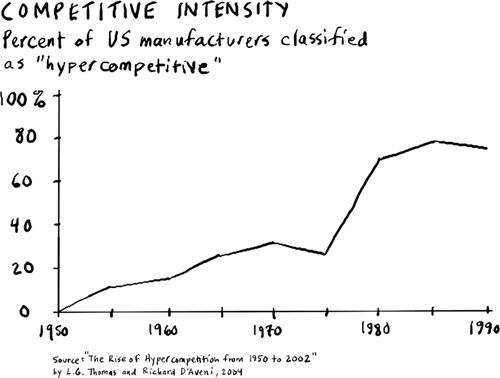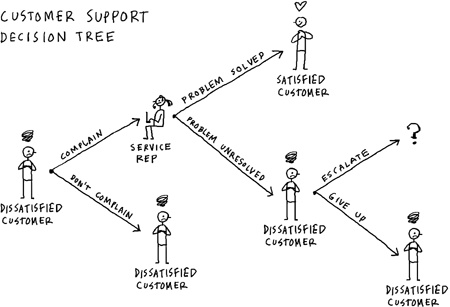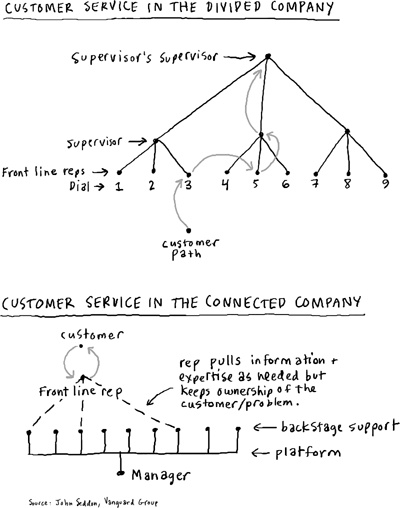Chapter 4. Services are complex
Most corporate systems were not built with customer delight in mind.
Services introduce customers into operations, which creates a lot of complexity and variability that is hard to plan for in advance. Companies must find ways to accommodate variety at the edge of the organization, where people and systems interact directly with customers, partners, and suppliers.
Demands on Companies are Increasing in Volume, Velocity, Variety
I have a friend who works at the U.S. Food and Drug Administration (FDA). One of the challenges the FDA is facing is that more and more drugs and devices are coming up for approval all the time, and the FDA has limited resources for evaluating and approving them. The more drugs and devices that come in to the system for approval, the fewer the FDA can actually look at in detail. In a world of limited budgets, this presents a major challenge that will only increase over time.
The same thing is happening in microchips. At one time, the chip business was focused primarily on chips for servers and PCs. Based on Mooreâs Law, chipmakers could predict the price and performance that would be required in 18 months and work to achieve it. The production cycles were predictable. But today, the world of devices has fractured into devices that serve all kinds of purposes, with all kinds of production cycles. Chips are embedded in almost everything, from sneakers to smart phones.
Competitive intensity is rising all over the world. Global competition and the Web have given customers more choices than they have ever had before. This means that customers can choose from an ever-widening set of choices, and it seems that variety only breeds more variety. The more choices that become available, the more choices it seems people want.
Customers have lots of things they are trying to do, and lots of ways they are trying to do them. And you have lots of competitors who are trying to offer them better, cheaper, faster, easier ways to do those things. And while customers are always looking for these better, faster, cheaper ways to do things, technology isnât standing still. As the front edge of technological change gets bigger, its surface area also grows, like an ever-expanding balloon. Every new technology adds one more set of capabilities that the next generation of technology can expand on.
Technology has a lot of effects. It reduces the friction of distance, it increases the variety of options and possibilities, it increases the velocity of just about everything, and it tends to also increase complexity and interdependency as more and more technologies build on and interoperate with each other.
In the coming century, the world will create a lot of variety. This is great for people who want more choices, but it creates a real problem for companies.
From drugs to microchips, from food service to entertainment, your customers will be expecting a lot of variety from you. They will want better quality, and they will want it faster and cheaper. They will expect you to respond quickly to their demands for personal and customized services. This change is real and itâs accelerating.
For most companies, business as usual just wonât cut it. What the market requires is not incremental improvement, but order-of-magnitude increases in performance. Are you ready to respond to these rising expectations?
Customers Introduce Complexity and Variability into Operations
You canât run service operations like a factory, because customers just walk onto the factory floor and mess everything up. They interfere. You canât schedule when they show up. They just come in massive waves at the most inconvenient times. Then they get angry when they have to wait. Why canât they make an appointment?
They donât understand how things work, so you have to train them to use the equipment. Sometimes they can be really slow to figure things out.
They ask for things that arenât on the menu. They want everything to be customized and personalized for them. They have no interest in efficient operations.
They donât follow the processes we lay out for them. As soon as you design a perfect voice menu system, they come up with some new problem that isnât on the menu and they have to talk to you. If you make a form, they need something that isnât on the form. They want to have a conversation.
And customers want to get on with their days. They donât want to wait in the waiting room or stay on hold for the next customer representative. They want services to be convenient for them. They want to get a coffee, get their hair done, and have lunch.
So customers introduce a massive amount of complexity into the Company Formerly Known as The Well-Oiled Machine. At the same time, competitors and even cooperating partners continually change the system as well. Instead of a stable landscape with peaks and valleys, you find yourself in a fluid landscape that looks more like waves in the ocean. As customers, competitors, and partners make adaptive moves and countermoves, they not only affect each other but they affect the landscape itself, so an organization that was fit for yesterdayâs world cannot be certain that they will be fit for tomorrowâs world.
Our companies have all been optimized for a perfect one-way stream, the line of production, and these pesky customers are mucking about in our operations, and we have now a completely different problem to solve. We need to optimize not for the line of production but for the line of interaction, the front lineâthe edge of the organizationâwhere our people and systems come into direct contact with customers. Itâs a whole different thing.
Why is it So Hard to Keep Your Service Promises?
Since services are created as they are delivered, the only way to sell them is by making a promise to perform. But most service companies fail to keep their promises, leaving customers frustrated, confused, and abused. Why do so many service companies fail to keep their promises to customers?
A 2011 study by American Express found that fewer than 1 in 10 customers say companies are exceeding their service expectations. Customers are not getting the service they want. Many feel abused. When they call your customer service line and hear a recorded voice saying, âYour call is important to us,â guess what? They donât believe you.
Customers have become accustomed to being abused by the companies they buy services from. Their expectations for most services are low, low, low. The most hated companies, and the most hated industries, are service providers.
Customers Resist Standardization
Many service companies just arenât designed for service delivery. They are designed like factories, optimized for the mass production of inputs into outputs. This makes perfect sense in a rapidly-industrializing economy. But in an economy where manufacturing is shrinking and services are expanding, it doesnât work anymore.
Traditional management thinking looks at a customer service call as an input to the service factory. For a factory, itâs not difficult to get standard inputs from suppliers. But inputs from customers come in all kinds of different shapes and sizes. Every problem, every job that customers need to do, has its own unique profile. Most companies try to standardize these inputs as much as possible so they can process them efficiently. The factoryâs job is to produce âresolutions.â This is how we end up with complicated voice menu systems that attempt to route calls to the appropriate department while keeping costs as low as possible.
As companies try to fit customer demands into standard boxes, customers become frustrated and angry. They give up. Sometimes they leave to find another provider, but even then they often hold little hope that anything will change.
Customer Support: Efficient for You, Painful for Them
Consider your last experience with your telephone, cable, or satellite provider; your utility provider; your airline; or your bank. Did you talk to a real person or an automated system? Did you have to ask to speak with a supervisor? Did you lose your temper? Did you swear? Did you hang up the phone in disgust? Did you not even call at all, because you knew it would not be worth the time and effort? You are not alone.
When customers are dissatisfied, there are only two possible outcomes. Either the issue is resolved to the customerâs satisfaction or it isnât. When it isnât, it becomes costly to your company. Trying to reduce or outsource your customer support costs might actually cost you a lot more in the long run, as you lose customers and they badmouth you to all their friends.
Consider what happens when you focus on costs in your customer service operations: the cheapest customer support call is the one that doesnât happen at all. Of course, you donât know why the customer didnât call you. Maybe they were happy with your service, or maybe they just didnât have the time or energy to fight their way upstream through your draconian support system. Thereâs just no way to know.
If youâre lucky and they do call you, there are still two possible outcomes. You satisfy the customer or you donât. Probably the cheaper outcome from a functional, departmental, cost-accounting perspective is the one where you quickly tell them itâs not possible or itâs not your department. You can mark that âresolved, not my departmentâ and forget about it. Maybe the customer will give up at that point.
If youâre still lucky, your customer will be patient as you bounce them around your system until they find the department that might be able to solve their problem. Once again, you have two possible outcomes: you satisfy the customer or you donât. Of course, while the customer bounces around they might get a little frustrated, but thatâs okay, because thatâs not your cost, itâs the customerâs cost. Itâs an âexternalityâ and it doesnât show up in your cost-accounting system.
Now that the customer has finally reached the right department, you still have two possible outcomes: you can resolve their problem or not. Itâs probably going to be cheaper not to solve their problem, because most of the time solutions have some kind of cost. You might have to accept a return, or credit the customerâs account. If the situation is not in the service representativeâs rule book, the service rep might not be able to help.
If youâre lucky, the customer will ask to speak to a supervisor. At that point, there are still two possible outcomes. You can solve the customerâs problem or say no. Itâs probably cheaper to say no, for the reasons outlined above. But maybe the supervisor will say yes, in which case thereâs a chance your customer will be satisfied.
Customers will put up with this kind of treatment only for so long. Eventually, they will find another company that treats them better. That would be great for you though, right? Because the cost of serving someone elseâs customer is zero! Yay for the cost savings team!
Then, when your customer tells all her friends about her experience, you will lose more customers. Your call center costs will continue to go down. At some point, when the last customer has left, you can eliminate your call center altogether. Total cost victory achieved.
Cost and Quality are Not Mutually Exclusive
Once youâre making a profit at something, and you feel like youâve got as many people buying it as are happy to buy it (market saturation), the next move is to try and to cut costs. Many companies assume that cutting costs will lead to lower quality. But that is not necessarily so.
Quality expert W. Edwards Deming once said that this is easy to understand. If you talk to a line worker in any factory, he said, just ask: âHow does improving quality reduce costs?â The answer will be simple: âLess rework.â
Cost-cutting can be a dangerous business. Itâs easy to cut costs in one area while unintentionally raising costs in another. Consider the costs that accrue when a customer calls in several times and talks to several people to get a single thing from the company. Consider the cost of a frustrated customer who gives up and finds another provider. Consider the costs involved in replacing customers that you lose through bad service. A company that truly serves customers well has vastly lower marketing and customer acquisition costs. Happy customers are the best marketing department any company could ever have.
All these costs are extremely important, but they are not easily counted. Many companies focus on those costs that are easily identified on the financial statements. But by cutting those costs, they are playing a shell game. In actuality, they are just moving those costs around. They are eating their own future: reducing todayâs costs at the expense of long-term customer relationships and customer loyalty. Pissed-off customers wonât stay any longer than they have to.
Customer Service Doesnât Have to be Painful
As a contrast, consider the Vanguard Group, an investment management company with $1.6 trillion in assets, offering mutual funds, financial products, and services to individual and institutional investors.
Calling a company for support is usually a headache. Usually, you start with a voicemail system and then you mess around for a while trying to find the right menu. Often, none of the menus exactly fit what you need, and it takes a while to get a real person on the phone. Then, when you finally get someone, you have to give them all your information even though you have already entered it into the system. They usually canât solve your problem, so they need to transfer you somewhere, where you need to give them your information all over again, and so on. Weâve all been there, right?
Vanguard customers have a vastly different experience. When you call Vanguard, you get a person on the phone, right off the bat. If the person canât help you, they will connect you to an expert, but they donât transfer you. They stay on the call.
âWe have very high client loyalty,â says Richard Dalton, Senior User Experience Manager at Vanguard. âLoyalty is pretty much everything to usâ¦the client is really at the center of literally everything we do.â
Control at the Edge
What does Vanguard do differently? They have inverted the traditional concept of control. The customer service representative has the control and authority to take ownership of the customerâs issue, and the rest of the company operates as a support network, available to the front-line representative as needed to answer the customer or solve their problem in one go.
Contrast this with the typical approach to customer service, where each person is so specialized that no single person can own a customer issue or resolve it, where the only person with a single view of the customerâs problem is the customer, who is then forced to deal with the company as if it were a fragmented, fractured personality.
The Vanguard rep can focus on the customerâs needs, with easy access to the entire companyâs database of information and expertise, as if it were a service. This means the Vanguard rep can truly act as an agent, working on behalf of the customer until the customerâs needs are met.
âWe put our crew right at the center of our success. Weâve said that consistently that the crew are fundamental to the success of this company, and we invest quite heavily in them.â
To truly accommodate customers, companies must invest real power and authority in the people and systems that interact directly with customers, at the edge of the organization.
Get The Connected Company now with the O’Reilly learning platform.
O’Reilly members experience books, live events, courses curated by job role, and more from O’Reilly and nearly 200 top publishers.




